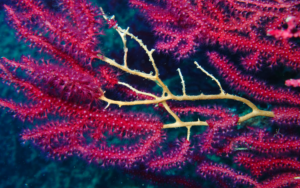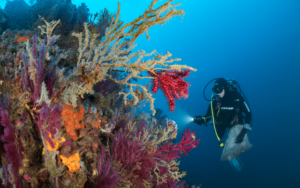A new study highlights the limited adaptive capacities of this iconic editerranean species to extreme climatic events that are increasingly frequent and intense.
The research work co-led by the Institut de Ciències del Mar (ICM-CSIC) and the Interdisciplinary Centre of Marine and Environmental Research (CIIMAR, Portugal), both partner organisations in MPA4Change project, in collaboration with the Faculty of Biology from Universitat de Barcelona has revealed that the red gorgonian (Paramuricea clavata) has low adaptability to the increasingly frequent and intense marine heatwaves. Published in the prestigious journal Global Change Biology, the research suggests that shallow populations of this emblematic species of the Mediterranean, could disappear, even in protected areas, owing to the recurrence of extreme events.
Testing gorgonian´s response to sea temperature raise
For the study, the research team developed an integrative approach combining experimental ecology, population genetics and analyses of in situ thermal regime. They conducted repeated common-garden thermal stress experiments over three consecutive years (2015-2017). To do these experiments, they collected samples from the exact same individuals of red gorgonians from several populations in the Medes Islands (Girona, Spain).

A Mediterranean red gorgonian (Paramuricea clavata) showing partial mortality from raising sea temperature – Photo by Joaquim Garrabou, CSIC.
During each experiment, the percentage of necrosis in the gorgonian tissues was measured as an indicator of their thermal stress responses. While in 2015 and 2016 the necrosis percentages at the end of the experiments were below 60%, in 2017 a significant increase in mortality was observed, with almost all colonies dead as the end of the experiment.
Statistical modelling demonstrates the summer thermal regime prior to the experiment as the main factor affecting the ecological response of the colonies during the three experiments. This also supports that adaptation, whether from genetic or phenotypic plasticity components, play a limited role in the response of this species to marine heat waves.
Main conclusions from the experts
“Our experiments show that the red gorgonian does not have the adaptive capacity to cope with the increasing frequency and intensity of heatwaves in the Mediterranean,” explains Sandra Ramírez-Calero, ICM-CSIC researcher and lead author of the study. “This lack of adaptation could lead to population collapses in shallow waters, even leading to local extinction”, adds.
Jean-Baptiste Ledoux (CIIMAR, Portugal), the study co-supervisor, adds: “The originality of this works relies on the fact that our experimental set-up allows to “control” for some of the drivers underlying the individual response to thermal stress. For instance, we used the exact same individuals during the three consecutive experiments, controlling de facto for the genetic component of the individual response to thermal stress.”
Joaquim Garrabou (ICM-CSIC), the study co-supervisor who also acts as the coordinator of MPA4Change project, concludes: “This study underscores the importance of considering the recurrence of extreme climatic events when making biodiversity projections, and suggests that traditional prediction methods may be insufficient.”
Considerations to protect Mediterranean gorgonians

The Mediterranean red gorgonian (Paramuricea clavata) is a habitat forming species that provides shelter to other organisms – Photo by Jordi Chias, CSIC.
Hence, the scientific team emphasises the need to move beyond traditional biodiversity predictions usually based on “single event approach” (i.e. assessment of ecological response based on one particular extreme climatic event) by considering the recurrence of heatwaves over the years.
In addition to its value as a symbol of Mediterranean ecosystems, the red gorgonian plays a key role as a habitat forming species. It increases habitat complexity creating refuge for numerous species. P. clavata is indeed essential for the structure and functioning of benthic communities and its disappearance, as stated by the research team, could simplify these ecosystems, affecting their ability to provide fundamental services to society.
Given this scenario, the scientific team stresses that although local conservation measures can be helpful, reducing greenhouse gas emissions remains the key piece to mitigating extreme climatic events linked to anthropogenic climate change and protecting the red gorgonian and other vulnerable species.


